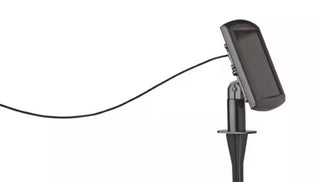 Solar panel
Solar panelIt's not hard to see why solar garden lighting is popular. Of course it's great that you don't have to pay for electricity, but more important for most folks is the fact that you don't need to install wiring. Take the light out of the box, put it beside your walkway or in your garden, and you're done. Because most solar lights have a built-in darkness sensor, you don't even need to think about turning them on and off. The technology for outdoor solar lighting is constantly improving. Solar lights are looking more attractive, shining more brightly, and their run-time is getting longer.
Getting the Most Out of a Solar Light
Placement of a solar light is all-important. For maximum solar gain, the solar cell should face due south and be positioned on an angle so it is perpendicular to the sun. The surface of the solar cell should not be shaded by foliage or structures at any time during the day. If the light has an automatic on-off sensor, it should not be placed near any other bright light source, such as a street lamp, because it may cause the light to shut off prematurely.
Six Things to Consider when Choosing a Solar Garden Light
- Solar Panel: The solar panel has a photovoltaic cell inside, which converts sunlight to an electrical current. A solar panel's effectiveness depends on the size and quality of the solar cell and the transparency of the protective cover. The solar cell itself is usually the most expensive part of a solar light. As photovoltaic technology advances, prices are gradually coming down. Note that some panels are shipped with a protective plastic film that's meant to be removed. If it's not removed, the panel will not charge properly.
- Battery: The solar cells are wired directly to a re-chargeable battery that stores the electricity generated by the cell. A diode located between the cell and the battery ensures that electricity flows only one way: into the battery. NiMH batteries are often used because they stand up better to the frequent charge and release cycles than standard NiCAD batteries. NiMH batteries also have a significant environmental benefit. They can be disposed of without harm to the environment. The battery is usually the second most costly component of a solar light.
- LED: "Light-emitting diodes" are like miniature light bulbs that are installed in-line on an electrical circuit. The light emitted by an LED bulb is the byproduct of electrons moving through a semi-conductor material. Since there's no need for a filament, these bulbs last a very long time and also do not generate waste heat. The standard runtime of most LEDs is upwards of 100,000 hours, while an incandescent bulb usually lasts for about 3,000 hours. LEDs can be wired in clusters to intensify the light output.
- Circuitry: This is the most crucial component of a solar light, and the one that most often separates the good solar lights from the bad. Wiring determines how efficiently the stored electricity is converted into light. High-quality circuitry will give you a longer-lasting, brighter solar light.
- Run Time: The quality and integration of the components described above determines how many hours the light will shine. Run times can be as short as an hour or as long as a few days. They either have a manual on-off switch or a photo sensor to turn on the light when darkness falls.
- Housing: Whether a solar light is strictly functional or highly decorative, its housing needs to be UV-stable and weather tight. Assembly should be minimal. In most cases, the solar panel will be an integral part of the light itself. Sometimes the solar panel is separate, which allows you to mount the light where you need it, and then mount the panel where it will get the best sun exposure.




